AAO-NANOS Neuro-Ophthalmology Clinical Collection: Derived from the AAO-NANOS Clinical Neuro-Ophthalmology collection produced on CD. The images are of selected cases from the NANOS teaching slide exchange, and the CD was produced under the direction of Larry Frohman, MD and Andrew Lee, MD.
The American Academy of Ophthalmology (AAO); The North American Neuro-Ophthalmology Association (NANOS).
NOVEL: https://novel.utah.edu/
TO
1 - 25 of 22
| Title | Creator | Description | ||
|---|---|---|---|---|
| 1 |
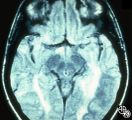 |
Magnetic Resonance Imaging in Detection of Extracranial Internal Carotid Artery Dissection | Marilyn C. Kay, MD | This 28-year-old woman presented with a 4-week history of bilateral visual loss. She had a known history of multiple sclerosis. Her vision was 20/60 OD and 20/40 OS, with an RAPD OS and optic pallor OU. Her fields and MRI are shown. Optic tract lesions usually result in an incongruous homonymous hem... |
| 2 |
 |
Neuro-Ophthalmic Case With Notable Field Changes | Marilyn C. Kay, MD | This 28-year-old woman presented with a 4-week history of bilateral visual loss. She had a known history of multiple sclerosis. Her vision was 20/60 OD and 20/40 OS, with an RAPD OS and optic pallor OU. Her fields and MRI are shown. Optic tract lesions usually result in an incongruous homonymous hem... |
| 3 |
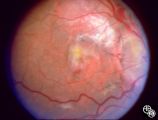 |
Isolated Congenital Optic Disc Anomalies | Anthony C. Arnold, MD | This patient has known pseudoxanthoma elasticum (an uncommon elastic tissue disorder characterized by plaque-like skin folds [plucked chicken skin] and degeneration of collagen fibers involving multiple systems, including the GI tract and heart), angioid streaks, and optic disc drusen. |
| 4 |
 |
Systemic Disorders With Optic Nerve and Retinal Findings | Robert F. Saul, MD | This patent has known pseudoxanthoma elasticum (an uncommon elastic tissue disorder characterized by plaque-like skin folds [plucked chicken skin], and degeneration of collagen fibers involving multiple systems, including the GI tract and heart), angioid streaks, and optic disc drusen. |
| 5 |
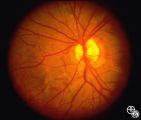 |
Systemic Disorders With Optic Nerve and Retinal Findings | Robert F. Saul, MD | This patent has known pseudoxanthoma elasticum (an uncommon elastic tissue disorder characterized by plaque-like skin folds [plucked chicken skin], and degeneration of collagen fibers involving multiple systems, including the GI tract and heart), angioid streaks, and optic disc drusen. |
| 6 |
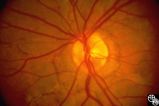 |
Systemic Disorders With Optic Nerve and Retinal Findings | Robert F. Saul, MD | This patent has known pseudoxanthoma elasticum (an uncommon elastic tissue disorder characterized by plaque-like skin folds [plucked chicken skin], and degeneration of collagen fibers involving multiple systems, including the GI tract and heart), angioid streaks, and optic disc drusen. |
| 7 |
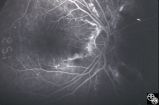 |
Systemic Disorders With Optic Nerve and Retinal Findings | Robert F. Saul, MD | This patent has known pseudoxanthoma elasticum (an uncommon elastic tissue disorder characterized by plaque-like skin folds [plucked chicken skin], and degeneration of collagen fibers involving multiple systems, including the GI tract and heart), angioid streaks, and optic disc drusen. Imaging of a... |
| 8 |
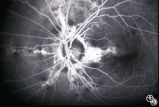 |
Systemic Disorders With Optic Nerve and Retinal Findings | Robert F. Saul, MD | This patent has known pseudoxanthoma elasticum (an uncommon elastic tissue disorder characterized by plaque-like skin folds [plucked chicken skin], and degeneration of collagen fibers involving multiple systems, including the GI tract and heart), angioid streaks, and optic disc drusen. Imaging of a... |
| 9 |
 |
Optic Tract Syndrome Due to Carotid Artery Dolichoectasia | Larry P. Frohman, MD | This 43-year-old man was referred for evaluation of 6 months of visual loss OU. In retrospect, he had noticed increasing difficulty with his tennis game dating back over 3 years, as balls would pass him unexpectedly when hit to his backhand (left) side. The patient did not think this was progressive... |
| 10 |
 |
Optic Tract Syndrome Due to Carotid Artery Dolichoectasia | Larry P. Frohman, MD | This 43-year-old man was referred for evaluation of 6 months of visual loss OU. In retrospect, he had noticed increasing difficulty with his tennis game dating back over 3 years, as balls would pass him unexpectedly when hit to his backhand (left) side. The patient did not think this was progressive... |
| 11 |
 |
Optic Tract Syndrome Due to Carotid Artery Dolichoectasia | Larry P. Frohman, MD | This 43-year-old man was referred for evaluation of 6 months of visual loss OU. In retrospect, he had noticed increasing difficulty with his tennis game dating back over 3 years, as balls would pass him unexpectedly when hit to his backhand (left) side. The patient did not think this was progressive... |
| 12 |
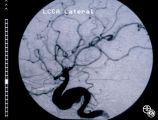 |
Optic Tract Syndrome Due to Carotid Artery Dolichoectasia | Larry P. Frohman, MD | This 43-year-old man was referred for evaluation of 6 months of visual loss OU. In retrospect, he had noticed increasing difficulty with his tennis game dating back over 3 years, as balls would pass him unexpectedly when hit to his backhand (left) side. The patient did not think this was progressive... |
| 13 |
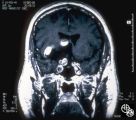 |
Optic Tract Syndrome Due to Carotid Artery Dolichoectasia | Larry P. Frohman, MD | This 43-year-old man was referred for evaluation of 6 months of visual loss OU. In retrospect, he had noticed increasing difficulty with his tennis game dating back over 3 years, as balls would pass him unexpectedly when hit to his backhand (left) side. The patient did not think this was progressive... |
| 14 |
 |
Optic Tract Syndrome Due to Carotid Artery Dolichoectasia | Larry P. Frohman, MD | This 43-year-old man was referred for evaluation of 6 months of visual loss OU. In retrospect, he had noticed increasing difficulty with his tennis game dating back over 3 years, as balls would pass him unexpectedly when hit to his backhand (left) side. The patient did not think this was progressive... |
| 15 |
 |
Optic Tract Syndrome Due to Carotid Artery Dolichoectasia | Larry P. Frohman, MD | This 43-year-old man was referred for evaluation of 6 months of visual loss OU. In retrospect, he had noticed increasing difficulty with his tennis game dating back over 3 years, as balls would pass him unexpectedly when hit to his backhand (left) side. The patient did not think this was progressive... |
| 16 |
 |
Optic Tract Syndrome Due to Carotid Artery Dolichoectasia | Larry P. Frohman, MD | This 43-year-old man was referred for evaluation of 6 months of visual loss OU. In retrospect, he had noticed increasing difficulty with his tennis game dating back over 3 years, as balls would pass him unexpectedly when hit to his backhand (left) side. The patient did not think this was progressive... |
| 17 |
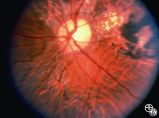 |
Ocular Manifestations of Congenital/Inherited Diseases | Steven Galetta, MD | This patient is a 40-year-old man with a history of abetalipoproteinemia (Bassen-Kornweig syndrome), diagnosed at age 9. Neurologic complications have included ataxia, retinal degeneration, peripheral neuropathy, progressive leg weakness, dysarthria, and intermittent bladder incontinence. On his neu... |
| 18 |
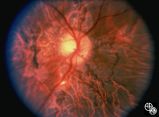 |
Ocular Manifestations of Congenital/Inherited Diseases | Steven Galetta, MD | This patient is a 40-year-old man with a history of abetalipoproteinemia (Bassen-Kornweig syndrome), diagnosed at age 9. Neurologic complications have included ataxia, retinal degeneration, peripheral neuropathy, progressive leg weakness, dysarthria, and intermittent bladder incontinence. On his neu... |
| 19 |
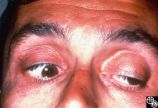 |
Ocular Manifestations of Congenital/Inherited Diseases | Steven Galetta, MD | This patient is a 40-year-old man with a history of abetalipoproteinemia (Bassen-Kornweig syndrome), diagnosed at age 9. Neurologic complications have included ataxia, retinal degeneration, peripheral neuropathy, progressive leg weakness, dysarthria, and intermittent bladder incontinence. On his neu... |
| 20 |
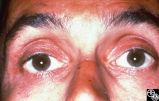 |
Ocular Manifestations of Congenital/Inherited Diseases | Steven Galetta, MD | This patient is a 40-year-old man with a history of abetalipoproteinemia (Bassen-Kornweig syndrome), diagnosed at age 9. Neurologic complications have included ataxia, retinal degeneration, peripheral neuropathy, progressive leg weakness, dysarthria, and intermittent bladder incontinence. On his neu... |
| 21 |
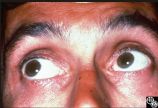 |
Ocular Manifestations of Congenital/Inherited Diseases | Steven Galetta, MD | This patient is a 40-year-old man with a history of abetalipoproteinemia (Bassen-Kornweig syndrome), diagnosed at age 9. Neurologic complications have included ataxia, retinal degeneration, peripheral neuropathy, progressive leg weakness, dysarthria, and intermittent bladder incontinence. On his neu... |
| 22 |
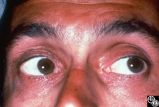 |
Ocular Manifestations of Congenital/Inherited Diseases | Steven Galetta, MD | This patient is a 40-year-old man with a history of abetalipoproteinemia (Bassen-Kornweig syndrome), diagnosed at age 9. Neurologic complications have included ataxia, retinal degeneration, peripheral neuropathy, progressive leg weakness, dysarthria, and intermittent bladder incontinence. On his neu... |
1 - 25 of 22
